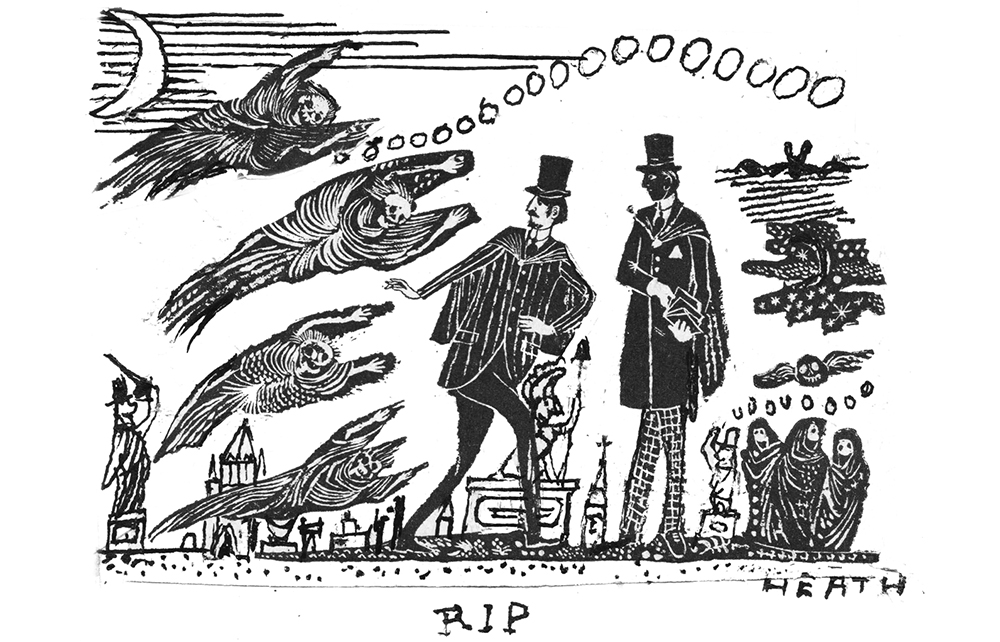Things are hotting up at Highgate Cemetery. Or they’ll need to if the grander tombs are to survive. During one cold spell last year, the huge mausoleum to Victorian banker Julius Beer froze on the inside as well as the outside, breaking some of the glass tiles. Lead lettering is another weak point – water gets into cracks, expands as it turns to ice, and forces letters off. So electric heating is being considered. The charity that looks after the cemetery admits this seems bizarre, ‘but it could save us a lot of money’.
The cemetery dates from 1839, one of London’s ‘Magnificent Seven’, which were opened to cope with the city’s expanding population. The initial design was by Stephen Geary, who also created the monument to George IV that gave King’s Cross its name, and who is in the cemetery himself. Fifteen acres were consecrated for Church of England use, with another two for dissenters (such as the scientist Michael Faraday). In 1860 an extension opened on the other side of Swain’s Lane. To avoid coffins having to cross the road after ceremonies in the chapel, a hydraulic lift and underground tunnel were built.
There are 53,000 graves (many of them family affairs – the body count is actually 170,000). You’d think a cemetery as celebrated as this one (it inspired Neil Gaiman’s The Graveyard Book) would have filled up years ago, but they’re still creating space for about 30 new plots each year. You can only buy them for immediate use – to purchase a plot in advance you must be over 80 or terminally ill. There’s an air of ‘standards’ about the website: until recently it decreed that visitors must be ‘suitably dressed – women must have their shoulders covered and men must not be bare-chested or wear vest-tops’.
As ever with a cemetery it’s the sheer variety that fascinates – all human life is here. The West Cemetery houses Charles Chubb (he of the locks), Charles Cruft (he of the dogs) and John Atcheler (Queen Victoria’s horse slaughterer). There’s Thomas Smith (inventor of the Christmas cracker) and Adam Worth, whose stone proclaims him ‘the Napoleon of crime’, a title awarded by a Scotland Yard detective. Arthur Conan Doyle borrowed it for Professor Moriarty.
More recent ‘Westies’ include Bob Hoskins, Lucian Freud (buried in a private ceremony by the then archbishop of Canterbury Rowan Williams), the footballer Ugo Ehiogu (‘Ain’t no sunshine when he’s gone’) and George Michael. Alexander Litvinenko is in a lead-lined coffin.
Over in the East Cemetery you’ll find the Great Train Robber Bruce Reynolds (‘This is it’ – the words he said as the train approached – plus a death mask created by his son), Mary Ann Cross (the stone gives both her real name and ‘George Eliot’), and Douglas Adams, who has a ceramic pot in which fans leave pens. The painter Patrick Caulfield designed his own headstone (‘D-E-A-D’), while that of Sonny Anderson (a boy who died in 2011) is cleverly made to look as though it contains a core of Lego.
But of course the cemetery’s most famous resident is Karl Marx. By a pleasing coincidence Marx is opposite Spencer (Herbert Spencer, the Victorian philosopher). The communist writer’s tomb was even mentioned in the sitcom Porridge – it was where Fletcher’s daughter Ingrid was conceived. Fletch and his girlfriend felt amorous on a visit, and ‘we needed somewhere flat’.






Comments